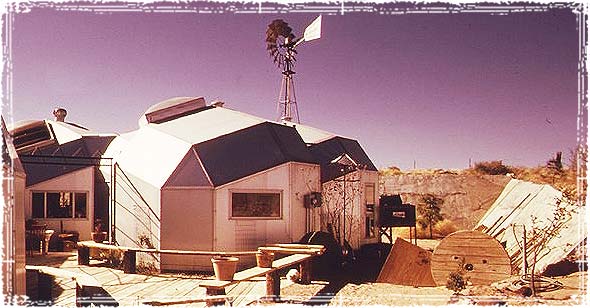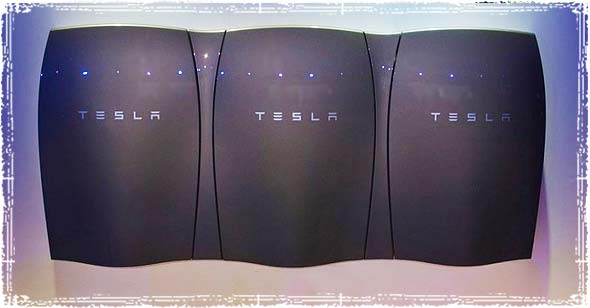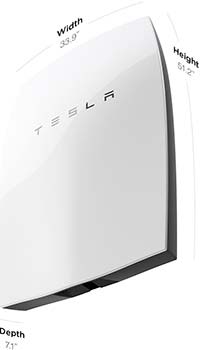As those who’ve made the leap can tell you, off-grid power is challenging to say the least. While it is possible to run a home on solar and wind, weather can quickly wreak havoc on your plans and can swiftly bring down even the best off-grid power setup.

One of the hardest things about going off the grid is finding a way to harness enough power to make the lifestyle realistic and affordable. While some people believe the answer is cutting consumption, renewable power billionaire Elon Musk thinks his Tesla Battery could hold the key to realistic Off-Grid Power.
Tesla Introduces their answer to Off-Grid power Storage

Elon Musk’s company Tesla is introducing a new energy storage solution that could revolutionize the renewable energy industry. The Powerwall, or Tesla Home Battery, is a wall-mounted energy storage unit — a rechargeable lithium-ion battery pack– that can hold 10 kilowatt hours of electric energy, and deliver it at an average of 2 kilowatts, all for US$3,500.
The Powerwall, by Tesla, is designed to hold a lithium-ion battery pack, liquid thermal control system, and software that receives dispatch commands from a solar inverter. It can be easily mounted on the wall and can even be integrated with the local grid for those who are just looking for an emergency backup power solution.
While Lithium battery technology isn’t exactly new, this will be the first time something of this scale will be introduced to the public. Musk says the problem with existing batteries is they “suck.” …” They are expensive and unreliable, stinky, ugly, bad in every way.”
Whether this is the ultimate solution to off-grid power storage is yet to be seen, but it is already sending shockwaves through the industry and causing others to bring newer battery technologies to the market – something that will help bring down the price of renewable energy technology and give more option to those who want to go off the grid.
Powerwall Specs:
 Mounting: Wall Mounted Indoor/Outdoor
Mounting: Wall Mounted Indoor/Outdoor- Inverter: Pairs with growing list of inverters
- Energy: 7 kWh or 10 kWh
- Continuous Power: 2 kW
- Peak Power: 3.3 kW
- Round Trip Efficiency: >92%
- Operating Temperature Range: -20C (-4F) to 43C (110F)
- Warranty: 10 years
- Dimensions: H: 1300mm W: 860mm D:180mm
Tesla claims their battery can provide a number of different benefits to the customer including:
- Load shifting – The battery can provide financial savings to its owner by charging during low rate periods when demand for electricity is lower and discharging during more expensive rate periods when electricity demand is higher
- Increasing self-consumption of solar power generation – The battery can store surplus solar energy not used at the time it is generated and use that energy later when the sun is not shining
- Back-up power – Assures power in the event of an outage
When can we expect the Powerwall to hit the Market?
The battery is already available for pre-order on the Tesla website, and is scheduled to start shipping within a few months. The Powerwall will be built right here in the United States at Musk’s new factory, the gigafactory, under construction currently in Nevada.
The unit will be available in 10kWh, optimized for backup applications or 7kWh optimized for daily use applications. They will be selling for $3500 for 10kWh and $3000 for 7kWh.




This sounds like just what I’m looking for could you send me the information on ordering it.
I would like more info please. I think this would work for my site! Thanks Scott
You guys fell for this?
Are you serious?
For example, what does this mean”optimized for daily use applications”?
This is vague marketing pap? Where are the depth of discharge curves? Where are the cyclical use curves?
They aren’t any because if you look at those, this junk is no different than VRLA cells…just lighter and poisonous as hell to dispose of.
If you want a 30-50 year battery it has to be a 2 volt wet cell that requires maintenance….PERIOD. You’dd nee 24 of them for a 48 volt system.
Elon Musk runs a car company that loses billions a year and survives only from bilking the US tax payer for green grants.
But don’t listen to me, go ahead and buy this junk.
Jim
John, dude, where have you been? The world is going to hell in a hand basket. Many folks are living off of 100ah batteries with a 500 to 1000 watts of solar power for a fridge, freezer, and a few lights, and a PC once in a while. That’s living free.
Hello Webmaster
Why haven’t you moderated my comments after over 12 hours
Glenn
Half of a good idea. Lithium is very expensive and hard to obtain. Sodium-ion batteries should be used instead.
You know those things that look segways with no handles? if they contain lithium-ion batteries, they could overheat and explode.
Lithium-ion does NOT cool well.
Sorry about that comment
Lithium-ion batteries are the reasons we don’t still have brick phones today
They are alot smaller than aluminium or nickel
Hello Webmaster
Why haven’t you moderated my comments after over 24 hours
Glenn
Hello Webmaster
Why haven’t you moderated my comments after over 48 hours
Glenn
Hey Guys
Have you ever heard of a “nickel iron battery”??
Lasts over a 100 years and can be discharged 100% daily without any damage to the battery and is completely non-toxic
For the best info on this battery go to:
nickel-iron-battery.com
This is not a commercial site – educational only
I Hope this helps you make a good choice
It’s a Very powerful solution
My setup produces 48 kilowatts daily even on cloudy days… it’s a very robust battery
Glenn
Glenn, are you 100% off grid?
I’ve been on solar power for 15 years and have gone through 2 sets of flooded lead acid batteries and am on the 3rd set now. I’m looking at this very seriously, but am skeptical enough to still hold reservations – primarily because the TESLA Company hasn’t had a stellar performance record to date. More investigation is in my very near future.
I wish I could believe in Musk and his battery backups, but he has yet to do anything right
dear mr. musk
If you are truly out to help with new technology, i”m 61 and my wheelchair bound husband is 70 and our system of surette batteries died. We live on s.security and would be more than grateful to try you power wall storage out. thank you